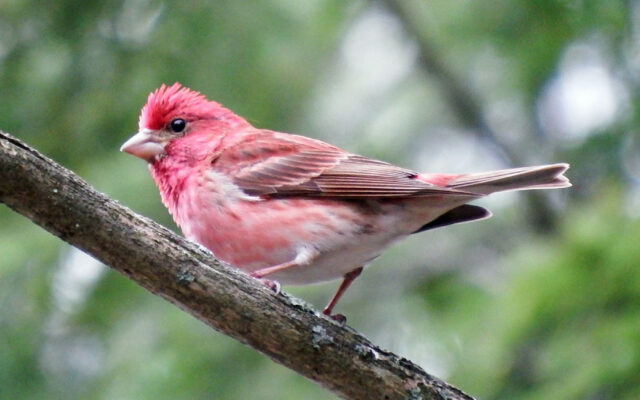
The Maine woods have been a smorgasbord for hardy birds this winter
By Bob Duchesne
To be honest, I’m going to miss winter. It’s been a while since we’ve had a season as birdy as this one, and I’m not just talking about the influx of Steller’s sea eagles. The northern forest has been busting out with birds like I’ve never seen.
Let’s compare notes. Feeder birds seem to be visiting in normal numbers. I’ve had more than 60 American goldfinches clobbering my nyjer feeders, but only one pine siskin has shown up, and no common redpolls.
That’s weird, because I can hear the siskins in my neighborhood. They’re just not coming to the feeders. Their absence is evidence that there is a ton of natural food in the woods this year.
That also explains why so many birds have stayed north. I’ve been up there enough to know that the numbers of white-winged crossbills, common redpolls, pine siskins, pine grosbeaks, evening grosbeaks and purple finches are off the charts north of Millinocket. But there is so much food, that few have bothered to come as far south as Bangor.
Some have. I’ve been surveying northern and eastern Maine as part of the Winter Bird Atlas project for the Maine Department of Inland Fisheries and Wildlife. Purple finches are plentiful in all their normal haunts. During my surveys closer to Bangor, I’ve found plenty of pine siskins, but almost no common redpolls. Pine grosbeaks usually come south to feed on the fruit and berries in eastern Maine, but this year, they’ve mostly stayed up in the woods.
The local birds have stayed put this winter, too. Blue jays, black-capped chickadees and red-breasted nuthatches aren’t your average migrants, but they will wander south if they think there won’t be enough food. Yes, they can tell. They’re Mainers. They know winter. It’s no different for them than it is for us to peek in the refrigerator to determine if we have enough food and coffee brandy to survive the winter. This year, they’ve stayed home.
It’s certainly different from last year. Food was scarce, and a wave of southbound Canadian birds washed over the state before Christmas and just kept on going, taking many of the jays, chickadees and nuthatches with them. Frankly, a bird walk in the North Woods was boring last winter.
The prior winter was also different. Goldfinches weren’t common, redpolls were scarce and siskin numbers were below average. Pine and evening grosbeaks were uncommon. But there were many white-winged crossbills and nearly as many red crossbills two years ago. Furthermore, they were singing like crazy, indicating an intention to stick around for the summer and make babies.
Every winter is different. That’s what makes it fun. It also makes it educational. With so many finches bounding around the treetops this year, I got a much better look at what their food preferences are.
Until now, I’ve been a little bewildered about the diets of the three smallest finches: goldfinches, redpolls and siskins. They’re all the same size. They all behave similarly. They all like seeds. So what’s the difference?
At the feeder, goldfinches are better equipped to deal with larger seeds, especially sunflower seeds. All three will eat nyjer, the thistle-like food that many backyard birders offer.
In the woods, goldfinches seek weedy seeds sticking above the snow. Siskins prefer conifer seeds, and are frequently in the tops of pines, spruces, hemlocks and tamaracks. Redpolls have a strong preference for the catkins that hang from birches and alders, especially in the clusters of roadside saplings.
Even though all these birds will flock together, especially in the morning when they’re picking grit from the road, I eventually learned to recognize which birds were more likely to be in which patch of forest, based on the types of trees present.
It was the same for purple finches. It took me most of the winter to notice that they always seemed to be in the tops of maples and yellow birches, perhaps with a taste for the buds on those trees.
White-winged crossbills seemed content among the spruces. Red crossbills exhibited a wider interest in hemlocks, pines and tamaracks, in addition to spruces. To my surprise, I found more of them closer to Bangor than the white-winged crossbills this year, probably because there are more pines and hemlocks in this part of the state. That’s also why the pine siskins flocked closer to Bangor.
March 15 is the last day for conducting Maine Bird Atlas late winter surveys. Spring is here. I’m sorry to see winter go.